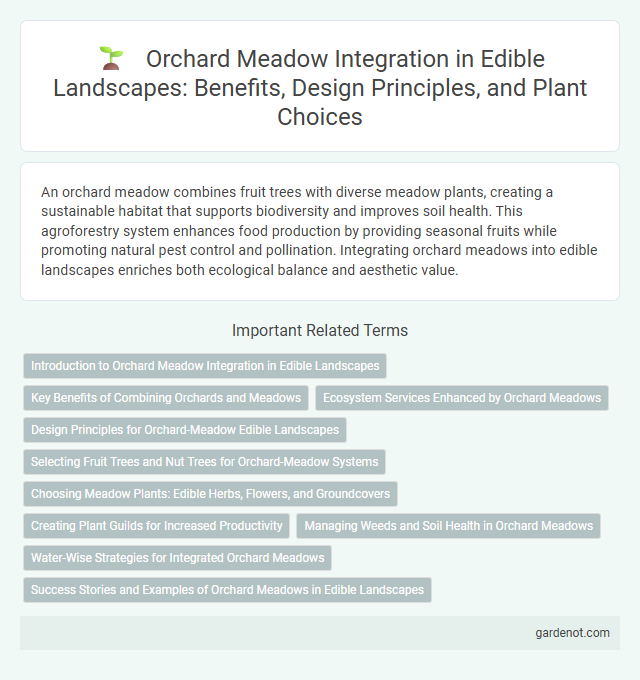An orchard meadow combines fruit trees with diverse meadow plants, creating a sustainable habitat that supports biodiversity and improves soil health. This agroforestry system enhances food production by providing seasonal fruits while promoting natural pest control and pollination. Integrating orchard meadows into edible landscapes enriches both ecological balance and aesthetic value.
Introduction to Orchard Meadow Integration in Edible Landscapes
Orchard meadows combine traditional fruit tree cultivation with natural meadow ecosystems, enhancing biodiversity and providing sustainable food sources. Integrating orchard meadows into edible landscapes promotes habitat diversity while yielding seasonal fruits such as apples, pears, and plums. This agroecological approach supports soil health, pollinators, and wildlife, making it an effective strategy for multifunctional land use.
Key Benefits of Combining Orchards and Meadows
Orchard meadows enhance biodiversity by integrating fruit trees with native meadow plants, creating habitats for pollinators and beneficial insects. This combination improves soil health through diverse root systems and organic matter, reducing erosion and increasing nutrient cycling. Yield stability increases as the layered ecosystem supports pest control and moisture retention, benefiting both fruit production and meadow plant growth.
Ecosystem Services Enhanced by Orchard Meadows
Orchard meadows significantly enhance ecosystem services by promoting biodiversity, supporting pollinators, and improving soil health through natural nutrient cycling. These landscapes serve as vital habitats for various bird species, insects, and microorganisms, which contribute to pest control and pollination. The integration of fruit trees with native grasses in orchard meadows also aids in carbon sequestration and water retention, fostering a resilient and sustainable agroecosystem.
Design Principles for Orchard-Meadow Edible Landscapes
Orchard meadow edible landscapes integrate diverse fruit trees with native meadow plants, fostering biodiversity and ecological resilience. Design principles emphasize layering plant species to optimize sunlight, soil health, and water management while ensuring habitat variety for pollinators and wildlife. Strategic spacing and species selection enhance yield and sustainability by balancing perennial fruit production with seasonal meadow growth.
Selecting Fruit Trees and Nut Trees for Orchard-Meadow Systems
Selecting fruit trees such as apples, pears, and plums with high disease resistance and adaptability to local soil conditions enhances productivity in orchard-meadow systems. Integrating nut trees like hazelnuts and chestnuts provides nutritional diversity and supports ecosystem resilience by attracting beneficial wildlife. Prioritize native or well-adapted tree varieties to optimize growth, minimize maintenance, and promote sustainable yield in orchard-meadow designs.
Choosing Meadow Plants: Edible Herbs, Flowers, and Groundcovers
Selecting meadow plants for an orchard landscape involves prioritizing edible herbs such as thyme, chives, and lemon balm, which enhance biodiversity and provide culinary benefits. Incorporating edible flowers like nasturtiums, calendula, and violets not only adds vibrant colors but also attracts pollinators essential for orchard productivity. Groundcovers like creeping thyme and wild strawberries prevent soil erosion, suppress weeds, and offer harvestable produce that complements orchard yields.
Creating Plant Guilds for Increased Productivity
Orchard meadows thrive by creating plant guilds that enhance biodiversity and boost productivity through complementary species interactions. Integrating nitrogen-fixing plants, dynamic accumulators, and beneficial insect attractors supports fruit tree health and yields. This polyculture approach optimizes nutrient cycling, pest control, and soil structure, resulting in a resilient and sustainable edible landscape.
Managing Weeds and Soil Health in Orchard Meadows
Effective weed management in orchard meadows involves using mulches and cover crops to suppress invasive species while promoting biodiversity. Maintaining soil health requires regular organic matter incorporation, such as compost or mulch, which improves nutrient availability and moisture retention. Crop rotation and minimal tillage practices enhance soil structure and microbial activity, supporting long-term orchard productivity.
Water-Wise Strategies for Integrated Orchard Meadows
Orchard meadows implement water-wise strategies such as deep-rooted fruit trees combined with native grasses that enhance soil infiltration and reduce evaporation. Integrating drought-tolerant understory plants and employing mulching techniques maintains soil moisture effectively. These practices promote sustainable water use while supporting diverse ecosystems within edible landscapes.
Success Stories and Examples of Orchard Meadows in Edible Landscapes
Orchard meadows blend fruit trees with diverse ground vegetation, creating resilient ecosystems that support both biodiversity and food production. Successful examples include Germany's traditional Streuobstwiesen, which sustain local economies and wildlife habitats by integrating apple, pear, and cherry trees with wildflowers and grasses. These orchard meadows exemplify sustainable edible landscapes by enhancing soil health, promoting pollinators, and providing a continuous harvest of fresh fruit and forage.
Orchard meadow Infographic

 gardenot.com
gardenot.com